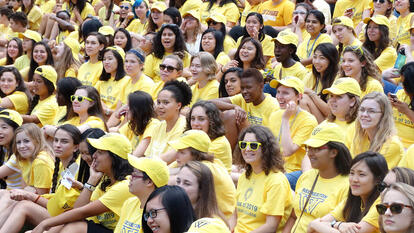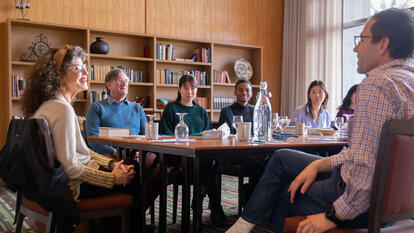Wellesley Professor Shines Spotlight on Boston’s Hidden Sacred Spaces

Wellesley’s Houghton Chapel is one of 50 sites featured in Boston’s Hidden Sacred Spaces, a project that spotlights chapels, meditation rooms, and prayer rooms that are “tucked around the corner, just out of view” around Greater Boston. Logan Airport, the Prudential Center, Hanscom Air Force Base, and the Isabella Stewart Gardner Museum are also in that group, along with several hospitals, malls, universities, and prisons. The project, developed by Wellesley’s Alice T. Friedman, Grace Slack McNeil Professor of the History of American Art and co-director of the Architecture Program, and Wendy Cadge, professor of sociology at Brandeis University, and with photographs by Randall Armor, was recently featured on WBUR radio and in a Boston magazine blog post.
The project was born after Cadge and Friedman, who specializes in architectural history, taught a seminar in 2012 at the Radcliffe Institute with Karla Johnson, a local architect who designed the Tufts Multifaith Center. The three had begun identifying and researching sites when Johnson died of cancer in early 2016; the project is dedicated to her memory.
“Karla helped us to remember the importance of ‘pause’—taking a few deep breaths, centering yourself, looking around at architecture and nature,” said Friedman in an interview. “This is important whether you are on campus, in the mall, or on a long walk, and even more so in places of high stress, loss, and potential regeneration like hospitals and prisons.”
The spaces Cadge and Friedman chose range from simple to ornate. Some are easily visible to passersby, while many are hidden in plain sight, such as St. Francis Chapel in the Prudential Center, which is nestled among retail stores and a Dunkin’ Donuts, or Our Lady of the Airways, the nation’s first airport chapel, built at Logan in 1951 and rebuilt in 1965. Both were constructed under the direction of Richard Cardinal Cushing, Boston’s archbishop until 1970, who believed that “workmen’s chapels” would help bring mass to the masses.
Those sites, like many featured in the project, reveal part of the area’s history, while others reflect more recent changes in response to an increasingly diverse population. For example, Beth Israel Deaconess Medical Center, created when two hospitals merged, has two chapels on its campus. One was originally a Jewish place of worship but was renovated to become interfaith; the other was created to look like a traditional Methodist church, but now has floor space where Muslims can pray, and a sign pointing toward Mecca.
Wellesley’s Houghton Chapel has also expanded and evolved over time, with the creation of the Multifaith Center in 2008 providing dedicated spaces for various faiths; Islamic wudus, or ablution stations, that allow for ritual washing before prayer; a meditation room; and a study. Early this year, three new stained glass windows featuring Choctaw and Cherokee designs were installed in the chapel.
Boston’s Hidden Sacred Spaces has received grants from Brandeis and Wellesley. A recent grant from Mass Humanities will support the development of a traveling exhibition.
Cadge and Friedman already have spoken about the project in several community settings, and will lecture and show slides in the next few weeks at the Newbury Court retirement community in Concord, Mass., and at Hebrew Senior Life at NewBridge on the Charles, in Dedham, Mass., both of which are featured in the project.
The team’s ultimate goal is to help people recognize the transformative power of sacred spaces around them that they might not have noticed before. “As our website says, those places are ‘tucked around the edges, just out of view,’” Friedman said.



